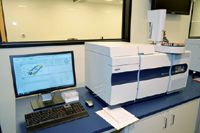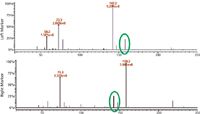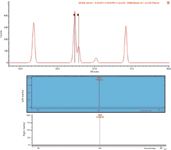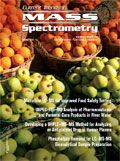Comparing Single Quadrupole with Triple Quadrupole GC–MS-Based Metabolomics
Special Issues
Bruker Daltonics, Inc.
Rob Trengove, Separation Science & Metabolomics Laboratory, Metabolomics Australia, Murdoch University, Murdoch, Western Australia
The emerging field of metabolomics is defined as the nontargeted detection and quantification of small molecule metabolites that are found in biological materials. With the advantage of noninvasive techniques, metabolomics is finding a growing number of applications in: chronic disease, environmental exposure, functional genomics, neonatal screening, nutrition, sports science, toxicology, and transplantation to monitor the health of the transplant organ.
To identify and quantify the vast range of chemically diverse primary and secondary metabolites, any analytical approach must encompass reliable sampling, precise detection methods, and advanced data handling and interpretation capabilities. With two recognized approaches to metabolomics, the first is referred to as "footprinting" (1) and is used when profiling metabolites within the environmental medium into which they were secreted by cells. Alternatively, a more untargeted method to metabolomics would be to analyze all metabolites present in a more blanketed approach much simpler and required less frequently, resulting in a more robust system for long operation.
Transitioning Single Quadrupole (SQ) to Triple Quadrupole (TQ) GC–MS
While metabolomics studies can be carried out using single quadrupole (SQ) GC–MS instruments, these rely heavily on mass spectra deconvolution and some derivatization for polar compounds such as amino acids, organic acids, and simple sugars (2). The application of single quadrupole GC–MS requires chromatographic temperature ramps and spectral scan rate to be matched in order to maximize the number of compounds that can be routinely identified for metabolite profiling. The scan rate becomes a limiting factor in metabolite profiling and the ability to effectively deconvolute data sets is critical.
To lessen the load of quantitative metabolomics, triple quadrupole (TQ) GC–MS has been utilized to excellent effect. The SCION™ TQ hardware (Figure 1) provides higher throughput and faster scan speeds for more efficient sampling runs, greater sensitivity, and zero cross talk and improved signal-to-noise ratio (S/N). Final outcomes include the ability to process more samples, resolve more compounds, and improve identification of compounds.

Figure 1: Bruker’s SCION GCâMS TQ platform with PC illustrating the compound-based scanning (CBS) software.
Experimental
The transition from single quad to triple quad can be illustrated with the use of GC–MS-MS with a standard 43 component mixture used for a QA/QC mix with derivatization (2).

Figure 2: Full scan mass spectrometry of 43 components QA/QC mix (TMS).
Figure 2 illustrates a typical full scan with a significant peak (3). Following close examination of the peak, total ion chromatogram coelution of proline and leucine was identified. The need for deconvolution to resolve these compounds was necessary (see Figure 3).

Figure 3: Upper: Full scan mass spectrometry of 43 components QC mix split (TIC filtered) with coelution at one peak.
Comparative Results: SQ vs TQ
When investigating metabolomic samples there are several hundreds of compounds and several may coelute. These compounds can be very similar in structure, such as sugars and deconvolution may not resolve them. Expanding the capabilities of the GC–MS-MS system is ideal with an instrument that undertakes data dependent MS and combines it with a series of scheduled multiple reaction monitoring (MRM) transitions. This extended system can be set-up to reference known coelution and accurate retention times of compounds.

Figure 4: Deconvolution of proline and leucine by compound-based scanning (CBS) software.
In Figure 4 the mass spectra of the left and right markers are quite similar and dependent on the speed at which data can be collected. Deconvolution may not resolve the two compounds in the peak, but if analysis by MS-MS is undertaken (Figure 5), the baseline is cleaned up significantly improving S/N, and the limits of detection (LOD) and quantification are greatly improved. It then becomes obvious that two peaks exist at this retention time (RT), whereas in full scan it was only a single peak with coelution. Using the triple quad system, it only takes one transition to resolve the compounds in this instance.

Figure 5: GCâMS-MS TQ of 43 components QA/QC mix illustrating two peaks for coeluted compounds proline and leucine.
Conclusion
A triple quadrupole operating in MRM mode with compound-based scanning (CBS) software provides enhanced duty-cycle coverage so that resolution of co-eluted compounds is possible in the SCION GC–MS TQ. It also provides a faster scan rate with lower LOD and this will lead to improved metabolome coverage with routine metabolite profiling using built-in libraries.
The TQ can also deliver precursor ion scans, product ion scans, neutral loss scans, and MRM to assist in the identification of unknowns as well as quantitatively detect metabolites in really complex mixtures at very low levels.
Chemical ionization (CI) in combination with MRM mode provides high throughput metabolomics capability, where as full scan struggles to resolve compounds. In addition, when using CI, an improved transmission is possible. With the right combination of reagent gases, compound identification is further improved, more compounds are resolved, and S/N is substantially better. CI also provides higher mass to charge (m/z) species of precursor ions for MS-MS with far less interference from the matrix. TQ MS that combines CI and MRM offers the potential to increase metabolome coverage and identification and provides both the LODs and improved precision required to do so.
Acknowledgments
Bruce Pebbles, Katherine Rousetty, Catherine Rawlinson, Garth Maker, Joel Gummer, Christian Krill, Hayley Abbis, and Bong Sze, Murdoch University; Australian Research Council, West Australian Government, Grain Research and Development Corporation, Grape and Wine Research and Development Corporation, Bioplatforms Australia and Murdoch University for funding; and Bruker Chemical and Applied Markets division.
References
(1) W.B. Dunn and D.I. Ellis, Trends in Analytical Chemistry 24(4), 285–294 (2005).
(2) S.L. Taylor et al., American Journal Renal Physiol. 298, F909–F922 (2010).
(3) "Transitioning from Single Quadrupole to Triple Quadrupole GC/MS-based Metabolomics" live webcast, LCGC N. America. October, 2011.
Bruker Daltonics, Inc.
Chemical and Applied Markets division
Fremont, CA
tel. +1 (510) 683-4300, Fax. +1 (510) 490-6586

Thermo Fisher Scientists Highlight the Latest Advances in Process Monitoring with Raman Spectroscopy
April 1st 2025In this exclusive Spectroscopy interview, John Richmond and Tom Dearing of Thermo Fisher Scientific discuss the company’s Raman technology and the latest trends for process monitoring across various applications.
A Seamless Trace Elemental Analysis Prescription for Quality Pharmaceuticals
March 31st 2025Quality assurance and quality control (QA/QC) are essential in pharmaceutical manufacturing to ensure compliance with standards like United States Pharmacopoeia <232> and ICH Q3D, as well as FDA regulations. Reliable and user-friendly testing solutions help QA/QC labs deliver precise trace elemental analyses while meeting throughput demands and data security requirements.